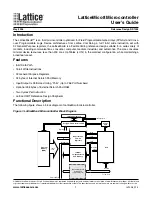
18 R/F CONVERTER (RFC)
18-2
Seiko Epson Corporation
S1C17M20/M21/M22/M23/M24/M25
TECHNICAL MANUAL (Rev. 1.0)
18.2 Input/Output Pins and External Connections
18.2.1 List of Input/Output Pins
Table 18.2.1.1 lists the RFC pins.
Table 18.2.1.1 List of RFC Pins
Pin name
I/O
*
Initial status
*
Function
SENBn
A
Hi-Z
Sensor B oscillation control pin
SENAn
A
Hi-Z
Sensor A oscillation control pin
REFn
A
Hi-Z
Reference oscillation control pin
RFINn
A
V
SS
RFCLK input or oscillation control pin
RFCLKOn
O
Hi-Z
RFCLK monitoring output pin
RFCLK is output to monitor the oscillation frequency.
*
Indicates the status when the pin is configured for the RFC.
If the port is shared with the RFC pin and other functions, the RFC input/output function must be assigned to the
port before activating the RFC. For more information, refer to the “I/O Ports” chapter.
Note: The RFINn pin goes to V
SS
level when the port is switched. Be aware that large current may flow
if the pin is biased by an external circuit.
18.2.2 External Connections
The figures below show connection examples between the RFC and external sensors. For the oscillation mode and
external clock input mode, refer to “Operating Mode.”
R
REF
R
REF
: Reference resistor
R
SEN1
: Resistive sensor (DC bias)
R
SEN2
: Resistive sensor (DC bias)
C
REF
: Reference capacitor
C
REF
R
SEN1
R
SEN2
S1C17 RFC
SENBn
SENAn
REFn
RFINn
*
Leave the unused pin (SENAn or SENBn) open if one resistive sensor only is used.
Figure 18.2.2.1 Connection Example in Resistive Sensor DC Oscillation Mode
R
REF
R
REF
: Reference resistor
R
SEN1
: Resistive sensor (AC bias)
C
REF
: Reference capacitor
C
REF
R
SEN1
S1C17 RFC
SENBn
SENAn
REFn
RFINn
Figure 18.2.2.2 Connection Example in Resistive Sensor AC Oscillation Mode
















































